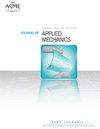单、双悬臂梁大位移混合模式断裂韧性试验方法及J积分分析
IF 2.8
4区 工程技术
Q2 MECHANICS
引用次数: 0
摘要
将j积分应用于单悬臂梁(SCB)和双悬臂梁(DCB)试件在ⅰ型和ⅱ型混合加载和大位移作用下的试验。所提出的方法和由此产生的封闭形式理论方程允许在实验室试验期间对J进行瞬时评估,只需要施加载荷和试样加载链接、加载点和剩余韧带的角度旋转。这些测量可以使用普通的称重传感器和标记,数字摄像机和视频分析软件来获得。一般来说,这些方程确实需要了解试件的弹性模量和剪切模量,以及试件的线性尺寸。由于可以在整个试验过程中即时分析和确定试验数据,并且由于几何非线性,在整个试验过程中I型和II型载荷的比例可能会发生显著变化,因此每个试样可以用于生成多个数据点。如果在整个试验过程中确定裂纹长度,可能是通过直接光学测量裂纹长度,那么当裂纹扩展时,可以使用本文的方法和结果确定混合模式加载的临界值J。值得注意的是,中等到较大的平移和旋转位移实际上提高了使用这些方法的结果的准确性。结果也适用于标准的纯I型或纯II型SCB和DCB试验,并在这些特殊情况下简化为已知方程。本文章由计算机程序翻译,如有差异,请以英文原文为准。
Single and Double Cantilever Beam Large Displacement Mixed Mode Fracture Toughness Test Methods and J-integral Analyses
The J-integral is applied to the single cantilever beam (SCB) and double cantilever beam (DCB) test specimens subjected to both mixed mode I and II loading and large displacements. The methods proposed and resulting closed form theoretical equations allow for the instantaneous evaluation of J during laboratory tests, requiring only the applied load and angular rotation of the specimen loading link, loading points and remaining ligament. These measurands can be acquired using a common load cell and markers, digital video camera, and video analysis software. In general, the equations do require knowledge of the specimen elastic moduli and shear moduli, as well as the specimen linear dimensions. Since the test data can be analyzed and J determined throughout the test instantaneously, and since, due to geometric non-linearities, the ratio of mode I and mode II loading will likely vary significantly throughout the test, each specimen can be used to generate multiple data points. If crack length is determined throughout the test, presumably by directly measuring the crack length optically, then when the crack advances, critical values of J for mixed mode loading can be determined using the methods and results presented. It is noted that moderate to large translational and rotational displacements actually improve the accuracy of the results using these methods. The results are applicable to standard purely mode I or purely mode II SCB and DCB tests as well and reduce to known equations in those special cases.
求助全文
通过发布文献求助,成功后即可免费获取论文全文。
去求助
来源期刊
CiteScore
4.80
自引率
3.80%
发文量
95
审稿时长
5.8 months
期刊介绍:
All areas of theoretical and applied mechanics including, but not limited to: Aerodynamics; Aeroelasticity; Biomechanics; Boundary layers; Composite materials; Computational mechanics; Constitutive modeling of materials; Dynamics; Elasticity; Experimental mechanics; Flow and fracture; Heat transport in fluid flows; Hydraulics; Impact; Internal flow; Mechanical properties of materials; Mechanics of shocks; Micromechanics; Nanomechanics; Plasticity; Stress analysis; Structures; Thermodynamics of materials and in flowing fluids; Thermo-mechanics; Turbulence; Vibration; Wave propagation

 求助内容:
求助内容: 应助结果提醒方式:
应助结果提醒方式:


